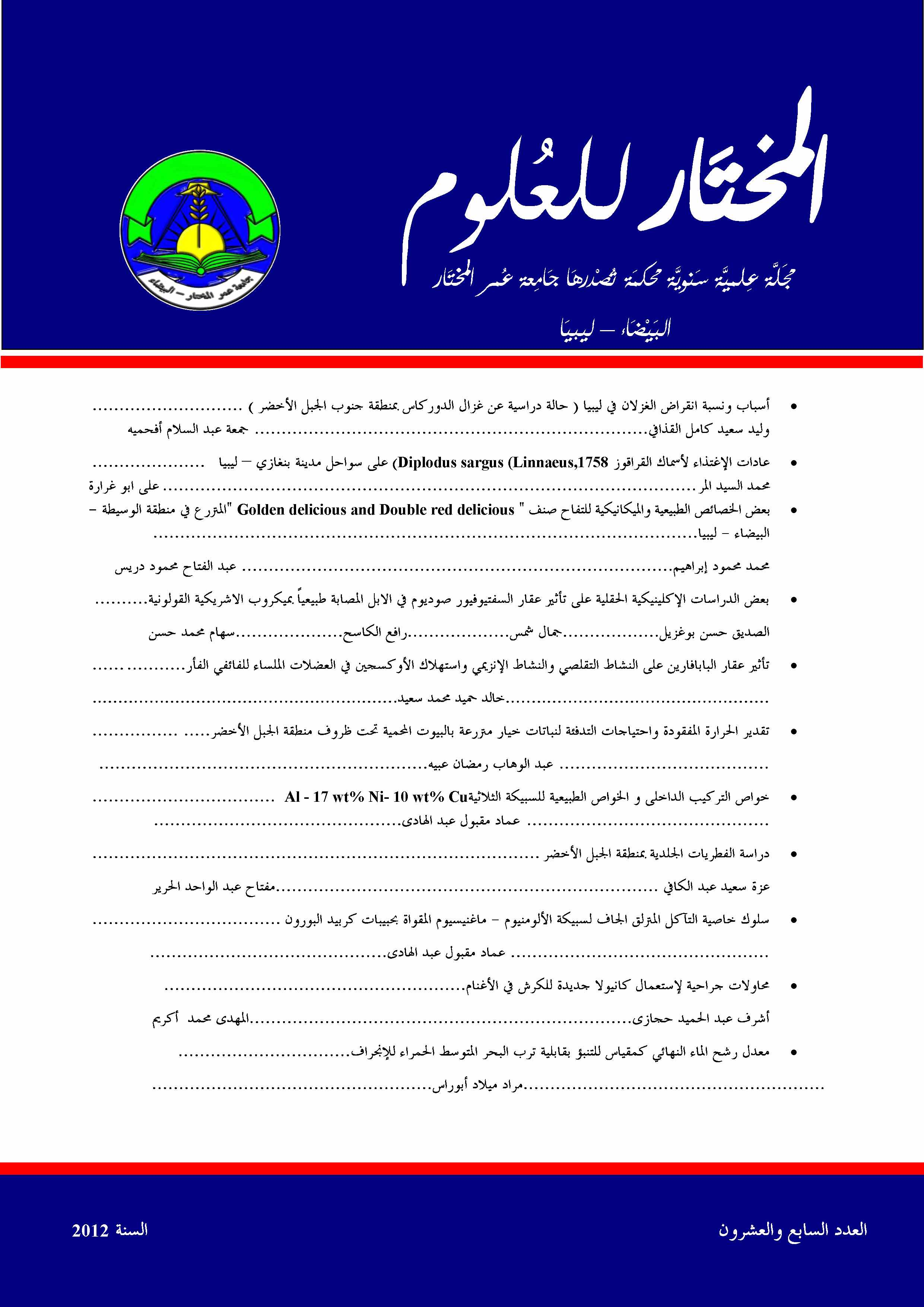Some clinical field studies on the effect of ceftiofour sodium in naturally E-Coli-Infected camels
DOI:
https://doi.org/10.54172/mjsc.v27i1.254Keywords:
Clinical field studies, Ceftiofour sodium, E-Coli-Infected, CamelsAbstract
The present investigation was conducted on twenty camels, fifteen of them were naturally- infected with E-coli microorganisms, the other five were apparently healthy. They were divided into two groups. The first group (5- camels) were served as a control one (non-infected, non treated). The second group (15- camels) were naturally infected with E-Coli and treated subcutaneously with ceftiofur sodium in a dose 5.0mg /kg.b-wt for three successive days. Two blood samples (one with anticoagulant and the other without anticoagulant) were collected from healthy camels and the naturally E-Coli-infected camels (before treatment and one-week post treatment) for hematological and biochemical determination. E-Coli-infected camels showed significant decrease in erythrocytic counts, Hb conc and PCV. It showed leucopenia, neutrapenia, lumphopenia associated with monocytosis in comparison to the control camels. It also, revealed lowering values of calcium, phosphorus, potassium, sodium, glucose, total serum protein, while GGt, ALP, serum urea and creatinine showed a higher values in comparison to control camels. All parameters and the signs of infected camels were improved towards the normal levels one week after treatment with ceftiofur sodium. The goal of our investigation was to evaluate the efficacy of ceftiofur sodium in naturally infected camels by determining the hematological and biochemical parameters of healthy and infected animals (pre and post treatment with ceftiofur sodium).
Downloads
References
Abd El-Latif, Ahlam and Gamal El-Din, Ibtisam (1998): The role of ceftiofur sodium in the control of pasteurella multocida infection, 4th , Scientific Medical Conference 26-28., Egypt.
Brander, G.C.; Pugh,D.M. and Bywater,R.J. (2005): Vet. App.Pharmacology and Therapeutics.8th Ed., London, Bailliere Tindall.
Brown, S.A.; Yancey, R.J. and Steffan, J. (1991): Ceftiofur sodium: antimicrobial activity of parent ceftiofur and metabolites, Acta. Vet. Scand. Supp. 87, 95-97.
Coles, E.H. (1986): Veterinary clinical pathology 4th. Ed. W. B. Saunder Compancy. Philadelphia, London. Hong Kong.
Cruick Shank,J.; Duguid,J.; Marmion, B.and Swain, R. (1975): medical microbiology 12th Ed.W.and Soliving Limited Edinburgh and London, 67-77.
Davis, B.J. (1964): Direct electrophoresis (method and application to human serum protein) Ann. NY. Acad. Sci. 121, 404-427.
Feldman, B.F. Zinkl, J.G. and Jain,N.C. (2000): Schalms Vet. Hematology. 8th Ed., Lippincott Williams, A water Co. Philadelphia, N.Y., London.
Gindler, M.E. and King.J.D. (1972): Rapid colorimetric determination of calcium in fluid, with B. methyl thymol Blue. Am.J. Clin. Path. 58: 376.
Goldenberg, H. (1966): Determination of inorganic phosphorus. Clin. Chem 12: 871.
Green wood, D. (1978): Activity of flumiquine against E.coli in Vitro in comparison with nalidixic acid and oxalinic acid. Ant.Microb. agent Chemoth. (13): 479-483.
Henry, R.J.; Cannon, C.D.; and Wenkelman,W.J. (1974): Clinical chem.. Principles and Techniques 2nd Ed. Harper and Row London.
Holt, J.; krieg, N.; Smeadb, P.; Staley, J. And Williams, S. (1994): Bergeys manual for derminative Bacteriology. 9th Ed. Williams and Wilkins Co.23-26.
Keline, L.K.; Yancey, R.J.; Case, C.A. and Salmon, S.A.(1996): minimum inhibitory concentrations of selected antimicrobial agents bacterial isolated from 1-14 day old broiler chicks.J. of Vet. Diagnostic investigation. 8: 494-495.
Oser, B.L. (1979): Hawks physiology chemistry. 14th Ed. Mc Graw Hill Co. Ltd., London, 48.
Panigraph, B.; Waibel, P.E. and Pomeray, B.S. (1969): Influence of E.Coli septicemia and nutrition on growth and tissue and fluid changes of the chicks. Poult. Sci., 48: 1695-1703.
Passwin, k. (1995): Software packet for statistical analysis (Underwindow U.S.A).
Patton, C.J. and Crouch, J.E. (1977): Enzymatic determination of urea. Anal. Chem. 49: 464-469.
Peters, T. (1968): Colorimetric method for determination of total serum proteins. Clin.Chem. 14: 1147.
Reynolds, D.J., Morgan, J.H. and Jones, P.W.(1986): Microbiology of calf diarrhaea in southern Britian. Vet.Rec., 119: 34-39.
RossKopf, W.J.; VanDewater, D. (1982): Hematological and blood chemistry values for common Avian Species. V.M.S.C. 77: 1233.
Salmon, S.A; Watts,J.L. and Yancey, R.J. (1996): In Vitro activity of ceftiofur and its primary metabolites desfuroyl-ceftiofur, against organisms of veterinary practice.J.Vet. Diag. Invest, 8 (3): 332-336.
Szasz, G. (1976): A colorimetric method for determination of γ. GT. Activity Clin.Chem. 22; 20561.
Thomas, L. (1978): alkaline phosphatase determination. Labor Diag. I.S. 64;Die Med. Ver lag., Maburg.
Thomson, T.D.; Quay,J.F. and Webber, J.A. (1984): Cephalosporin group of antibacterial drugs. J. of Am. Vet. Med. Assoc., 185, 1109-1114.
Trinder, P. (1969): Enzymatic colorimetric methods for determination of Glucose. Ann. Clin. Biochem. 6: 24.
Walts, J.L; Salmon, S.A.; Yancey, R.J., Nersessian, B. and Kounev, Z.V. (1993): minimum inhibitory concentrations of bacteria isolated from septicemia and air sacculitis in ducks. J.Vet. Diag n .Invest., 5(4): 625-628.
Yancey, R.J. Evans, R.A. Dalkratzer, D. and Carmer, S.G. (1990): Efficacy of ceftiofur for treatment of experimentally induced collibacillosis in neonatal swine. Am. J. of Vet. Res. 51(3): 349–353.
Downloads
Published
How to Cite
License

This work is licensed under a Creative Commons Attribution-NonCommercial 4.0 International License.
Copyright of the articles Published by Almukhtar Journal of Science (MJSc) is retained by the author(s), who grant MJSc a license to publish the article. Authors also grant any third party the right to use the article freely as long as its integrity is maintained and its original authors and cite MJSc as original publisher. Also they accept the article remains published by MJSc website (except in occasion of a retraction of the article).










